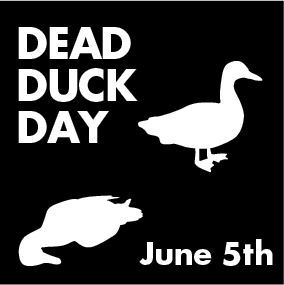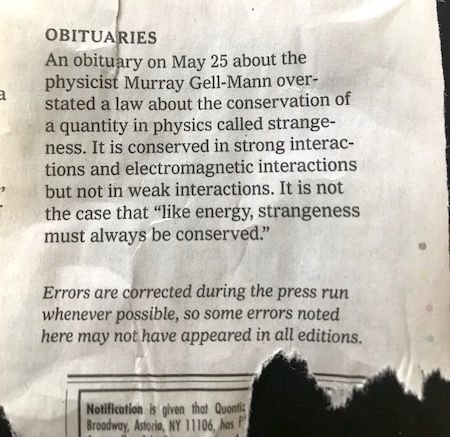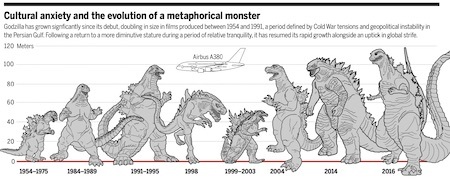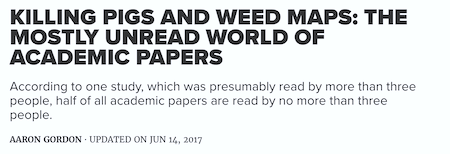Marc Abrahams's Blog, page 146
June 4, 2019
The Strangeness Correction About Murray Gell-Mann
This strangeness correction appeared in today’s New York Times:
OBITUARIES
An obituary on May 25 about the physicist Murray Gell-Mann overstated a law about the conservation of a quantity in physics called strangeness. It is conserved in strong interactions and electromagnetic interactions but not in weak interactions. It is not the case that “like energy, strangeness must always be conserved.”
(Thanks to noted New York attorney William J. Maloney for bringing this to our attention.)

Watching text flow…: ASCII Fluid Dynamics
ASCII Fluid Dynamics, in video form:
(Thanks to Mason Porter for bringing this to our attention.)

Wednesday is Dead Duck Day
 The 24th annual Dead Duck Day celebration happens on Wednesday, June 5, 2019. Dead Duck Day honors the mallard duck that became known to science as the first (documented) ‘victim’ of homosexual necrophilia in that species, and earned its discoverer, Kees Moeliker, the 2003 Ig Nobel Biology Prize.
The 24th annual Dead Duck Day celebration happens on Wednesday, June 5, 2019. Dead Duck Day honors the mallard duck that became known to science as the first (documented) ‘victim’ of homosexual necrophilia in that species, and earned its discoverer, Kees Moeliker, the 2003 Ig Nobel Biology Prize.
Kees Moeliker, who is now director of the museum where the incident occurred, invites everyone to join in the celebration:
Dead Duck Day also commemorates the billions of other birds that die(d) from colliding with glass buildings, and challenges people to find solutions to this global problem.
Please join the free, short open-air ceremony next to the new wing of the Natural History Museum Rotterdam (the Netherlands), right below the new Dead Duck Memorial Plaque — the very spot where that duck (now museum specimen NMR 9989-00232) met his dramatic end….
After the ceremony, join us for the traditional six-course (dead) duck dinner at the famous Tai Wu Restaurant. This dinner, also, is open to the public (at your own expense). Reserve your seat by e-mailing to: info [at] hetnatuurhistorisch.nl
[Read full details on Kees’s blog.]
Here is the TED Talk Kees did about the duck:

June 3, 2019
Lipstick obsession and red urine [case study]
“
A 28-year-old woman presented to the nephrology clinic with a 5-day history of passage of red-colored urine (Figure 1a) without dysuria flank pain, rigors, or chills. She denied any history of recent exposure to medications, beet intake, or coloring agents in food. On examination, the only noticeable feature was her bright-red lipstick (Figure 1b). Her blood count, serum creatinine, liver function, and urine tests were normal. Her urine culture was sterile. On further questioning, she revealed that she would apply her lipstick 20 to 25 times a day and was finding it hard to overcome this obsession.”
Fortunately, the patient fully recovered – after refraining from the (over)use of red lipstick. See: Lipstick obsession and red urine in Kidney International (the official journal of the international society of nephrology), July 2018, Volume 94, Issue 1, Page 223.
Also see: (two follow-up articles, in Kidney International, Vol. 94, Issue 4) Regarding ”Lipstick obsession and red urine” and The author replies
Research research by Martin Gardiner

“Researchers retract a paper because it turns out not to be about bullshit”
Researchers retract a paper because it turns out not to be about bullshit
…a group of environmental scientists in China… lost their 2019 article on soil contamination because what they thought was manure was in fact something else.
The article, titled “Immobilization of heavy metals in e-waste contaminated soils by combined application of biochar and phosphate fertilizer,” appeared in February in Water, Air, & Soil Pollution…
the retraction notice says all that crap wasn’t crap after all:
“The authors have retracted this article. After publication they became aware that the data for cattle manure biochar reported in this article are actually data for rice straw biochar. The results, discussion and conclusions are therefore invalid. All authors agree with the retraction.”
Believe it or not, this paper isn’t the first one linked to manure that we’ve covered. That spot goes to this 2011 article, and a co-author who claimed that his data were lost when they fell into a pit of bullshit.

May 31, 2019
Innovative Scientists Talk About Their Childhood (1): Frans de Waal’s Jackdaws
Here’s Frans de Waal talking about some jackdaws that, when Frans was a child, excited him in a way that led to his eventual unusual career. Frans studies chimps, bonobos, macaques, capuchin monkeys, and other of our close relatives. He wants to understand how and why they (and we) do some of the impressive things they (and we) do every day.
ABOUT THIS LITTLE VIDEO SERIES—This is part of a series of sessions we (David Hu and I, and a film crew) recorded at Georgia Tech. We assembled a little group of scientists (including David) who are renowned for looking at questions others might overlook, and doing research in inventive, clever ways.
The question we asked them: “What happened when you were a kid that somehow led—much later—to your doing unusual science?”
The scientists: David Hu, Suzana Herculano-Houzel, Frans de Waal, Nicole Sharp, Diego Golombek, and Olga Shishkov. Follow the links on their names to begin exploring some of their work!
A FURTHER NOTE ABOUT THIS SERIES: These little videos are not quite as good as they ought to have been, due to curious decisions made by the video editor. The most obvious of those strange decisions was to dose everything with goopy, slightly distracting music. The editor also objected to some of the content of the videos, deeming them somehow too offensive to record. The lesson we learned: choose our video editor more carefully.

May 30, 2019
Calculating a Fearful Evolution of Godzilla
A movie monster, appearing in different forms in a series of movies, proves inspirational to two calculating scientists. They explain their calculations, in this study:
“A Movie Monster Evolves, Fed by Fear,” Nathaniel J. Dominy and Ryan Calsbeek, Science, vol. 364, no. 6443, May 31, 2019, pp. 840-84. (Thanks to Tony Tweedale for bringing this to our attention.)
The authors, at Dartmouth College, explain:
The “evolutionary biology” of Godzilla is a topic of enduring interest among devotees…
Godzilla has grown signficantly since its debut, doubling in size in films produced between 1954 and 1991, a period defined by Cold War tensions and geopolitical instability in the Persian Gulf. Following a return to a more diminutive stature during a period of relative tranquility, it has resumed its rapid growth alongside an uptick in global strife.
BONUS (possibly unrelated): The Taxonomy of Barney

Reinforcing bitumen-based road surfaces with waste from plastic wigs [study]
“Synthetic hair wigs are made from modacrylic fibers that are synthesized to look and feel same as real hair. The fibers have the potential to return to their original shape by spraying it lightly with water and heating from underneath. Moreover, synthetic fibers do not keep odours and do not react to weather condition as easily as natural hair wigs. Direct disposal of the PA [Polyacrylic] wig as hazardous waste product is the least complicated compared to disposal of other contaminated crop materials and may prove to be the most practical. However, it is the less preferable method since it is also very costly. Therefore, the best solution to handle this waste is by blending with the asphalt binder or otherwise known as polymer modified bitumen (PMB).”
A research team, from the Faculty of Chemical and Natural Resources Engineering, Universiti Malaysia Pahang (UMP), Malaysia, suggest that their new recycling insight regarding the addition of PolyAcrylic Wig Waste (PAWW) to bitumen products used in road-making might be able to help reduce accident rates.
“Poor road condition can contribute to accidents especially for motorcyclists. The use of fiber reinforced road micro surfacing can lead to better road surface quality and the rate of accidents could also be reduced.”
See: Modification of bitumen using polyacrylic wig waste in AIP Conference Proceedings, volume 1930, 020051 (2018);
BONUS: Hot bitumen can cause severe burns, but can be removed with butter.
Research research by Martin Gardiner

May 29, 2019
Some Arithmetic About Non-Reading of Writing
Aaron Gordon’s writing about written reports that few people have read has probably been read more than most reports about reports that few people have read. Gordon’s report about reports was published in Pacific Standard:
At one of the first academic conferences I ever attended, I heard an economist joke that dissertations are only read by three people: the author, their advisor, and the committee chair. It’s funny in the way that academic jokes are funny: not actually funny but it gets listeners to nod along with the central truth. This specific central truth must resonate with established academics, since I heard versions of this same joke at nearly every conference I attended thereafter.
Like many jokes, this particular one turns out to be half true. A burgeoning field of academic study called citation analysis (it’s exactly what it sounds like) has found that this joke holds true for not just dissertations, but many academic papers….
A Perhaps Larger Question: Business Reports
Gordon’s report (like many similarly-intentioned reports by many other people) does not look into a related question: Of all the reports written in businesses and other non-academic organizations, how many are read by anyone other than the person who writes them?
Reporting on a Report About Reports About Reports
Such questions are not without honor. Perhaps the highest honor accorded so far is the 2012 Ig Nobel Prize for literature. That prize was awarded to the US Government General Accountability Office, for issuing a report about reports about reports that recommends the preparation of a report about the report about reports about reports.
That prize-winning report about reports about reports is: “Actions Needed to Evaluate the Impact of Efforts to Estimate Costs of Reports and Studies,” US Government General Accountability Office report GAO-12-480R, May 10, 2012.

May 28, 2019
The Ig Nobel Prizes are a category on Jeopardy, for the 8th time
The television quiz show Jeopardy used the Ig Nobel Prizes as a category, in the program broadcast on May 23, 2019. This was the eighth time the Igs have been a Jeopardy category (previous appearances were in 2005, 2006, 2008, 2010, 2012, 2016, 2018). Here are the answers from the new session:
The contest was exciting, reports the Inquirer Journal:
Bolton native gives ‘Jeopardy!’ champ a scare
… For a thrilling half-hour Thursday night, Bolton native Nathan Scheffey kept “Jeopardy!” audiences across the country pinned to their television sets with a nearly neck-and-neck performance against game show phenomenon James Holzhauer, at one point not just leading but almost tripling the reigning champion’s score….
While tearing through subjects ranging from American history to musicals to the satirical Ig Nobel Prize, Scheffey racked up two daily doubles, and by the time contestants entered the Double Jeopardy! round, he was leading Holzhauer $19,400 to $6,600.
Even the usually unflappable Trebek took notice, musing to the studio audience that it was “hard to believe” Scheffey’s early dominance….

Marc Abrahams's Blog
- Marc Abrahams's profile
- 14 followers









